Xiaosong Yuan
Efficient Reasoning Through Suppression of Self-Affirmation Reflections in Large Reasoning Models
Jun 14, 2025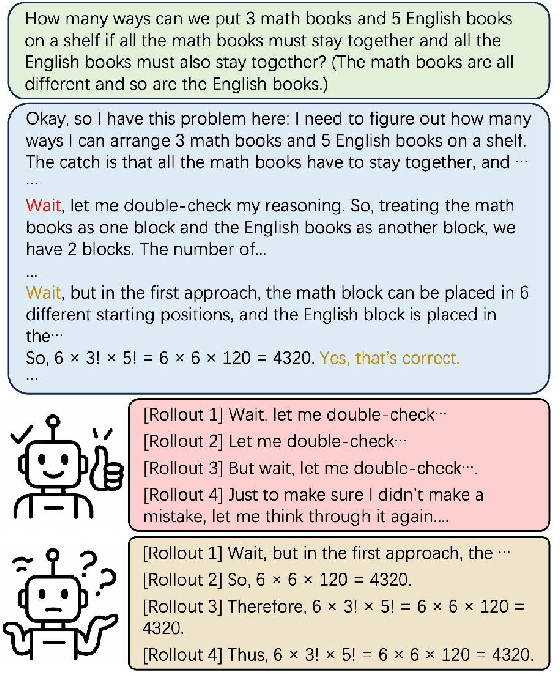
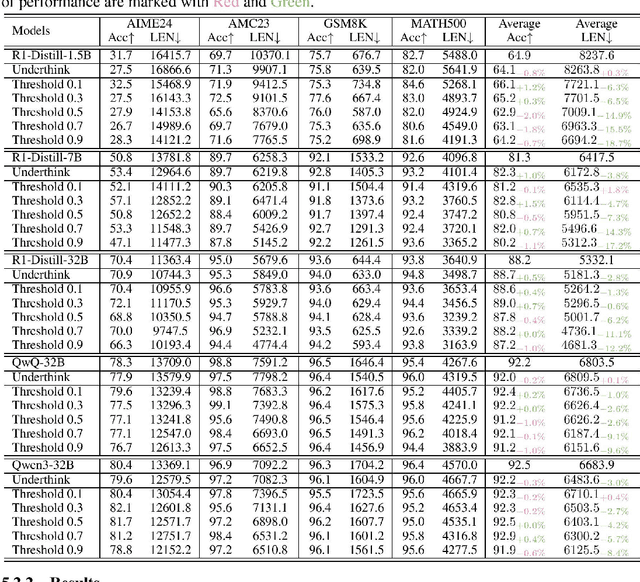
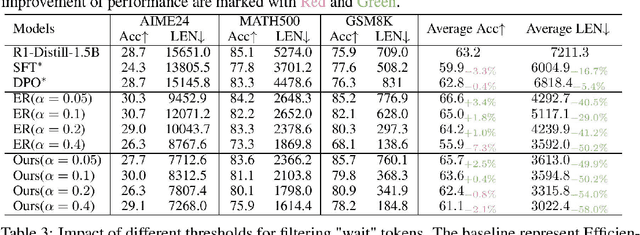
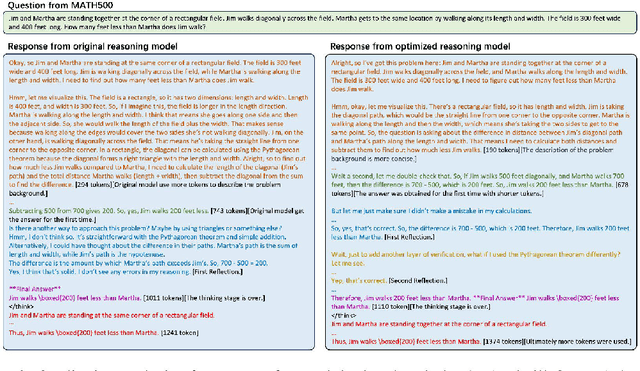
Abstract:While recent advances in large reasoning models have demonstrated remarkable performance, efficient reasoning remains critical due to the rapid growth of output length. Existing optimization approaches highlights a tendency toward "overthinking", yet lack fine-grained analysis. In this work, we focus on Self-Affirmation Reflections: redundant reflective steps that affirm prior content and often occurs after the already correct reasoning steps. Observations of both original and optimized reasoning models reveal pervasive self-affirmation reflections. Notably, these reflections sometimes lead to longer outputs in optimized models than their original counterparts. Through detailed analysis, we uncover an intriguing pattern: compared to other reflections, the leading words (i.e., the first word of sentences) in self-affirmation reflections exhibit a distinct probability bias. Motivated by this insight, we can locate self-affirmation reflections and conduct a train-free experiment demonstrating that suppressing self-affirmation reflections reduces output length without degrading accuracy across multiple models (R1-Distill-Models, QwQ-32B, and Qwen3-32B). Furthermore, we also improve current train-based method by explicitly suppressing such reflections. In our experiments, we achieve length compression of 18.7\% in train-free settings and 50.2\% in train-based settings for R1-Distill-Qwen-1.5B. Moreover, our improvements are simple yet practical and can be directly applied to existing inference frameworks, such as vLLM. We believe that our findings will provide community insights for achieving more precise length compression and step-level efficient reasoning.
Improving Complex Reasoning with Dynamic Prompt Corruption: A soft prompt Optimization Approach
Mar 17, 2025



Abstract:Prompt-tuning (PT) for large language models (LLMs) can facilitate the performance on various conventional NLP tasks with significantly fewer trainable parameters. However, our investigation reveals that PT provides limited improvement and may even degrade the primitive performance of LLMs on complex reasoning tasks. Such a phenomenon suggests that soft prompts can positively impact certain instances while negatively affecting others, particularly during the later phases of reasoning. To address these challenges, We first identify an information accumulation within the soft prompts. Through detailed analysis, we demonstrate that this phenomenon is often accompanied by erroneous information flow patterns in the deeper layers of the model, which ultimately lead to incorrect reasoning outcomes. we propose a novel method called \textbf{D}ynamic \textbf{P}rompt \textbf{C}orruption (DPC) to take better advantage of soft prompts in complex reasoning tasks, which dynamically adjusts the influence of soft prompts based on their impact on the reasoning process. Specifically, DPC consists of two stages: Dynamic Trigger and Dynamic Corruption. First, Dynamic Trigger measures the impact of soft prompts, identifying whether beneficial or detrimental. Then, Dynamic Corruption mitigates the negative effects of soft prompts by selectively masking key tokens that interfere with the reasoning process. We validate the proposed approach through extensive experiments on various LLMs and reasoning tasks, including GSM8K, MATH, and AQuA. Experimental results demonstrate that DPC can consistently enhance the performance of PT, achieving 4\%-8\% accuracy gains compared to vanilla prompt tuning, highlighting the effectiveness of our approach and its potential to enhance complex reasoning in LLMs.
Seeing Clearly by Layer Two: Enhancing Attention Heads to Alleviate Hallucination in LVLMs
Nov 15, 2024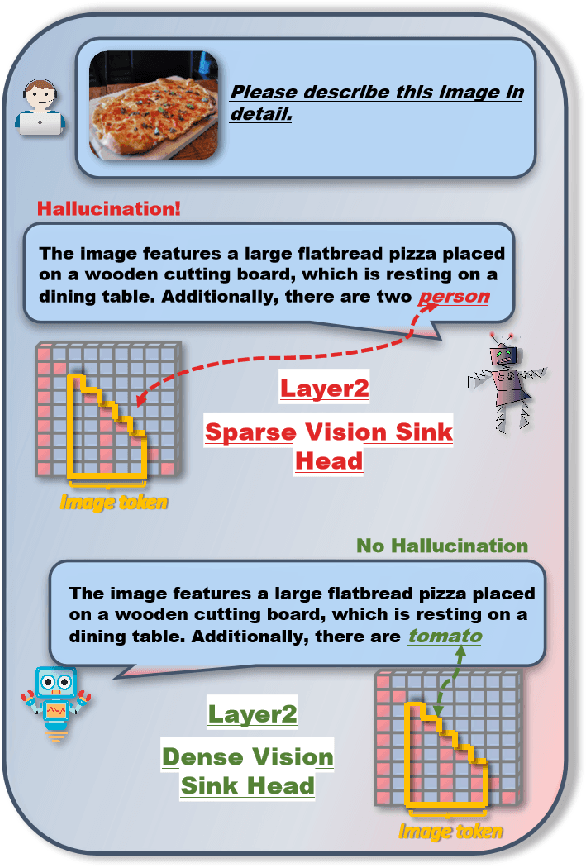
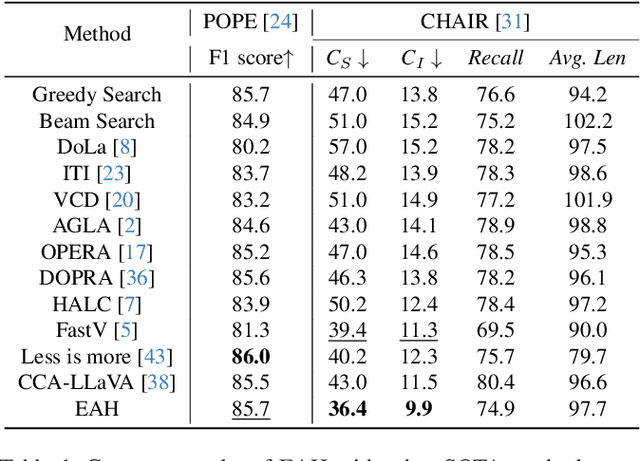
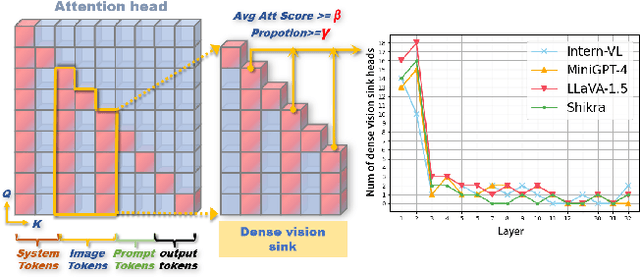
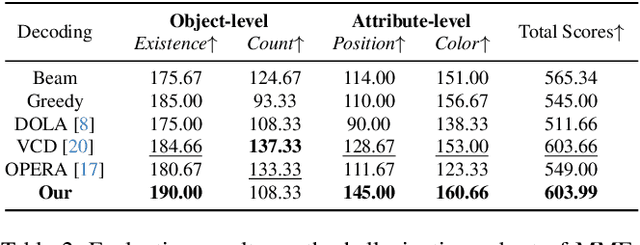
Abstract:The hallucination problem in multimodal large language models (MLLMs) remains a common issue. Although image tokens occupy a majority of the input sequence of MLLMs, there is limited research to explore the relationship between image tokens and hallucinations. In this paper, we analyze the distribution of attention scores for image tokens across each layer and head of the model, revealing an intriguing and common phenomenon: most hallucinations are closely linked to the pattern of attention sinks in the self-attention matrix of image tokens, where shallow layers exhibit dense attention sinks and deeper layers show sparse attention sinks. We further analyze the attention heads of different layers and find that heads with high-density attention sink in the image part play a positive role in alleviating hallucinations. In this paper, we propose a training-free method named \textcolor{red}{\textbf{E}}nhancing \textcolor{red}{\textbf{A}}ttention \textcolor{red}{\textbf{H}}eads (EAH), an approach designed to enhance the convergence of image tokens attention sinks in the shallow layers. EAH identifies the attention head that shows the vision sink in a shallow layer and extracts its attention matrix. This attention map is then broadcast to other heads in the layer, thereby strengthening the layer to pay more attention to the image itself. With extensive experiments, EAH shows significant hallucination-mitigating performance on different MLLMs and metrics, proving its effectiveness and generality.
Instance-adaptive Zero-shot Chain-of-Thought Prompting
Sep 30, 2024



Abstract:Zero-shot Chain-of-Thought (CoT) prompting emerges as a simple and effective strategy for enhancing the performance of large language models (LLMs) in real-world reasoning tasks. Nonetheless, the efficacy of a singular, task-level prompt uniformly applied across the whole of instances is inherently limited since one prompt cannot be a good partner for all, a more appropriate approach should consider the interaction between the prompt and each instance meticulously. This work introduces an instance-adaptive prompting algorithm as an alternative zero-shot CoT reasoning scheme by adaptively differentiating good and bad prompts. Concretely, we first employ analysis on LLMs through the lens of information flow to detect the mechanism under zero-shot CoT reasoning, in which we discover that information flows from question to prompt and question to rationale jointly influence the reasoning results most. We notice that a better zero-shot CoT reasoning needs the prompt to obtain semantic information from the question then the rationale aggregates sufficient information from the question directly and via the prompt indirectly. On the contrary, lacking any of those would probably lead to a bad one. Stem from that, we further propose an instance-adaptive prompting strategy (IAP) for zero-shot CoT reasoning. Experiments conducted with LLaMA-2, LLaMA-3, and Qwen on math, logic, and commonsense reasoning tasks (e.g., GSM8K, MMLU, Causal Judgement) obtain consistent improvement, demonstrating that the instance-adaptive zero-shot CoT prompting performs better than other task-level methods with some curated prompts or sophisticated procedures, showing the significance of our findings in the zero-shot CoT reasoning mechanism.
From Redundancy to Relevance: Enhancing Explainability in Multimodal Large Language Models
Jun 04, 2024



Abstract:Recently, multimodal large language models have exploded with an endless variety, most of the popular Large Vision Language Models (LVLMs) depend on sequential visual representation, where images are converted into hundreds or thousands of tokens before being input into the Large Language Model (LLM) along with language prompts. The black-box design hinders the interpretability of visual-language models, especially regarding more complex reasoning tasks. To explore the interaction process between image and text in complex reasoning tasks, we introduce the information flow method to visualize the interaction mechanism. By analyzing the dynamic flow of the information flow, we find that the information flow appears to converge in the shallow layer. Further investigation revealed a redundancy of the image token in the shallow layer. Consequently, a truncation strategy was introduced to aggregate image tokens within these shallow layers. This approach has been validated through experiments across multiple models, yielding consistent improvements.
TC-GAT: Graph Attention Network for Temporal Causality Discovery
Apr 21, 2023



Abstract:The present study explores the intricacies of causal relationship extraction, a vital component in the pursuit of causality knowledge. Causality is frequently intertwined with temporal elements, as the progression from cause to effect is not instantaneous but rather ensconced in a temporal dimension. Thus, the extraction of temporal causality holds paramount significance in the field. In light of this, we propose a method for extracting causality from the text that integrates both temporal and causal relations, with a particular focus on the time aspect. To this end, we first compile a dataset that encompasses temporal relationships. Subsequently, we present a novel model, TC-GAT, which employs a graph attention mechanism to assign weights to the temporal relationships and leverages a causal knowledge graph to determine the adjacency matrix. Additionally, we implement an equilibrium mechanism to regulate the interplay between temporal and causal relations. Our experiments demonstrate that our proposed method significantly surpasses baseline models in the task of causality extraction.
 Add to Chrome
Add to Chrome Add to Firefox
Add to Firefox Add to Edge
Add to Edge